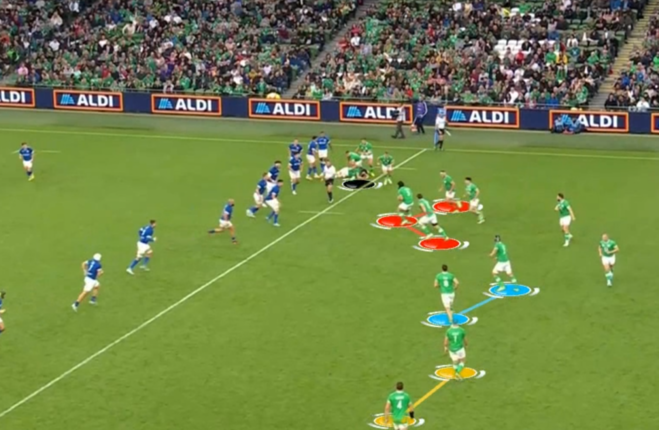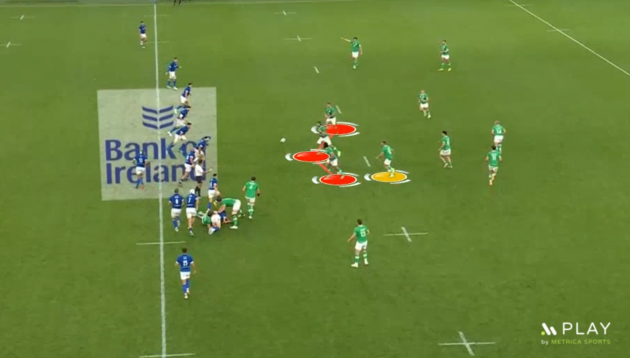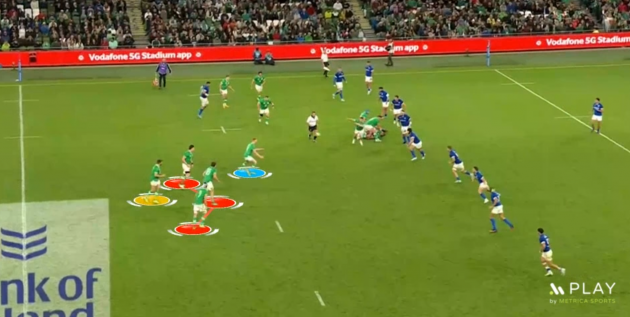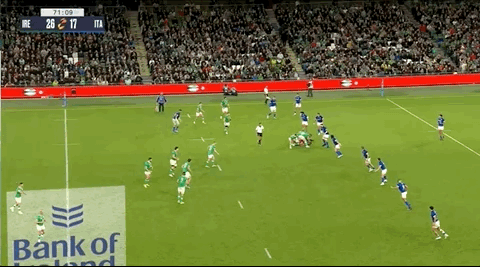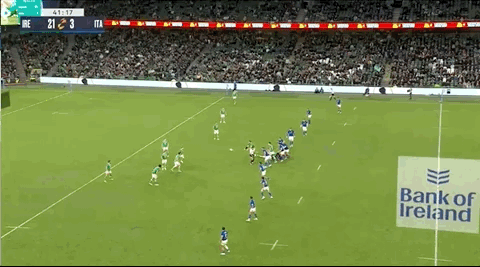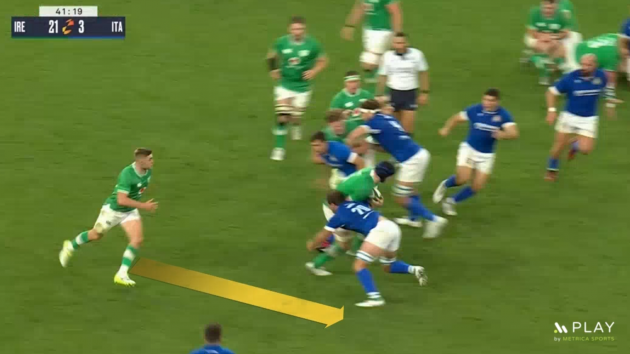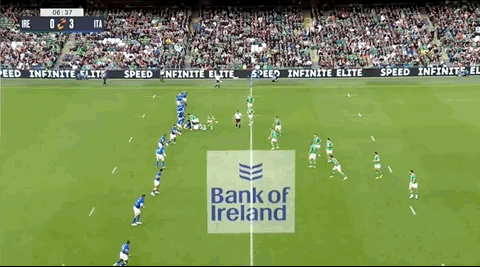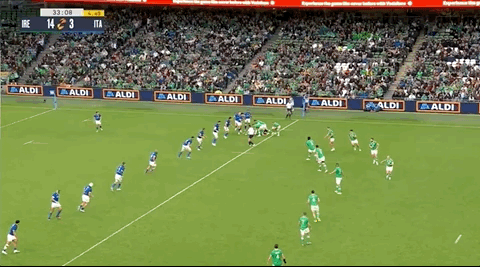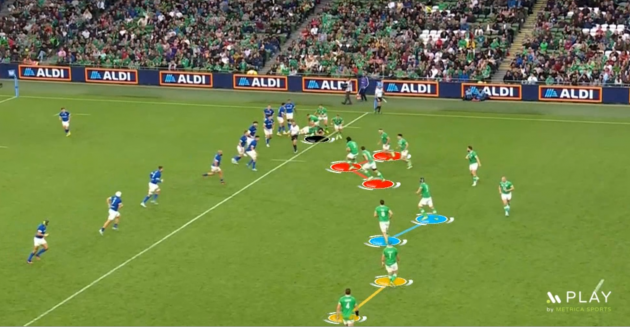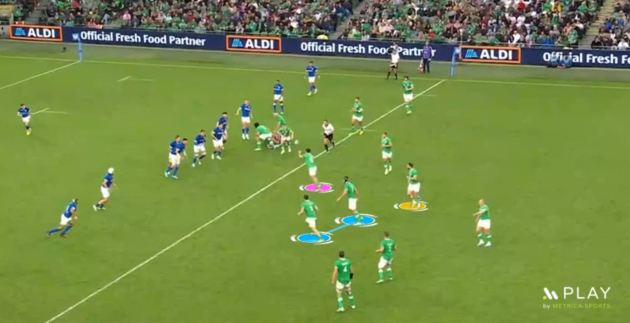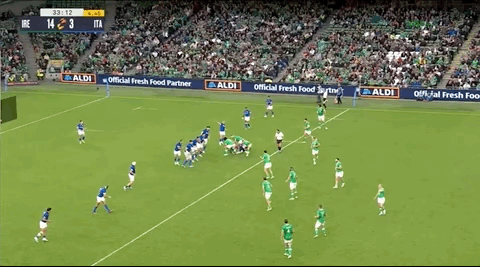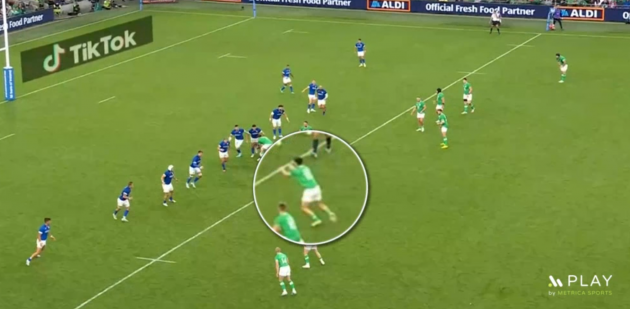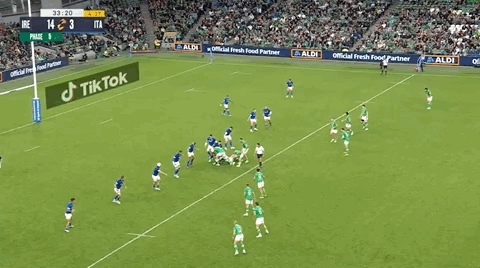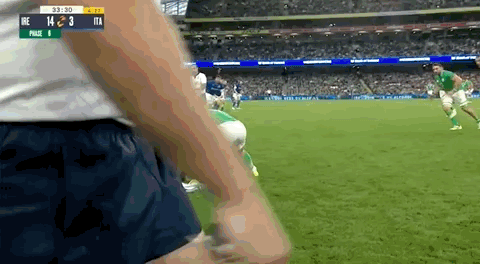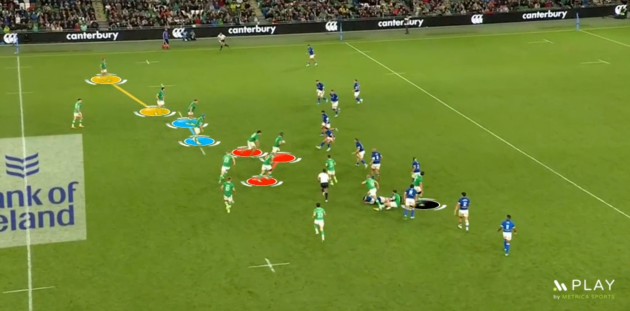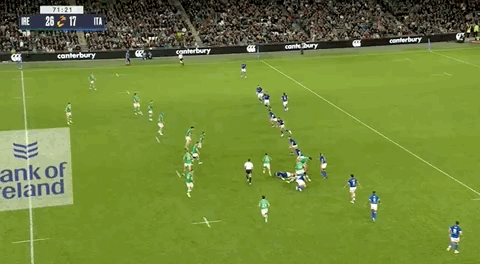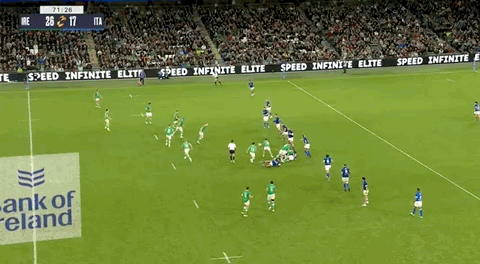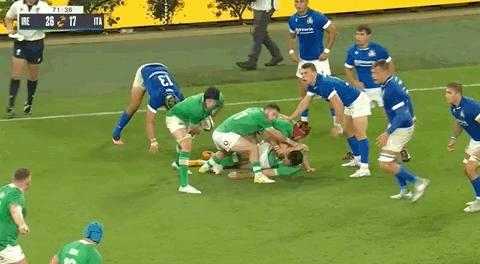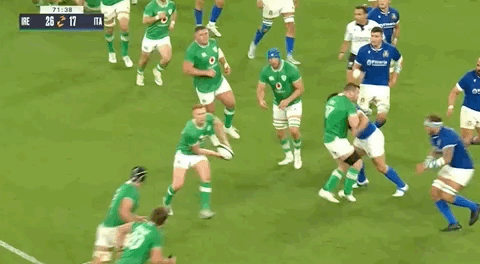ANDY FARRELL’S IRELAND at their best have great flow in their phase-play attack. Their ability to deliver fluidity, connection, and decision-making prowess in this part of the game is arguably their superpower.
There were only glimpses of what Ireland are capable of against Italy two weekends ago but we saw hints of development in their phase-play attack.
Some teams have basic phase play predominantly focused on forwards carrying after receiving a pass from the scrum-half, but Ireland have lots of intricacies and subtleties in theirs. So much so that many other sides have mimicked them.
With that in mind, Farrell and co. are clearly intent on adding new layers to their phase-play attack to keep defences guessing.
We saw signs of one new flourish against Italy that Ireland may look to build on as they face England in their second World Cup warm-up game in Dublin this evening [KO 5.30pm, RTÉ].
First, let’s take a quick refresher on some of Ireland’s basic phase-play traits.
Below, we see a familiar set-up from Ireland ‘off 9′ – meaning when they have a pod of forwards set up to receive the ball directly from the scrum-half. It’s actually lock Iain Henderson acting as the makeshift scrum-half, but the shape is what we’re interested in.
In this instance, there’s a pod of three forwards [highlighted in red above] with a back [yellow] set up in ‘the boot’ position behind. There are multiple options for Caelan Doris in the middle of the pod of forwards.
Doris can carry the ball himself, throw a short ‘tip-in’ pass back inside to Tom O’Toole, throw a short ‘tip-on’ pass outside to Dave Kilcoyne, or play a ‘sweep’ pass out the back to Jack Crowley.
As we see below, Doris opts to go out the back to Crowley as Ireland move the ball out to their right.
Ireland regularly use a similar set-up when they play ‘off 10′ – meaning the scrum-half passes to the out-half or another back, with a pod of forwards operating outside that back.
We see an example below as scrum-half Caolin Blade passes to Crowley [blue] at 10 and he has a pod of three forwards [red] outside him, with another Irish back [yellow] in the boot.
Cian Prendergast is in the middle of the pod of forwards this time but his options are the same as Doris’ in our example off 9. Prendergast can tip-in to Joe McCarthy, tip-on to Doris, or sweep the ball to Stuart McCloskey in the boot.
Prendergast opts to carry himself on this occasion.
The extra wrinkle that Ireland seemed keen to add to their game against Italy came within these basic shapes.
In essence, they appear to have put focus on the player set up ‘in the boot’ becoming an option for an offload after a tip-on pass within the pod of three forwards.
There were a handful of examples in the game – some successful, some not – including the one below in the second half as Ireland play off 9, with Henderson standing in as scrum-half again.
Prendergast tips the ball on to fellow back row Ryan Baird and Crowley sweeps up from behind to offer an offload option, which Baird rightly takes.
The whole idea of the tip-on pass is that the passing player can interest defenders with his own carrying threat before playing a late pass to a team-mate running at speed into a hint of space and therefore dominating the collision. Oftentimes, winning collisions means players can get their hands through for offloads, so this simple development from Ireland makes sense.
Rather than the back who is in the boot immediately fading away to focus on the next phase of attack when they don’t receive a sweep pass, Ireland’s coaches have seemingly asked them to be more active in looking for an offload.
On other occasions, Ireland weren’t able to get the ball away after the tip-on pass.
Watch below as Ireland play off 10 and Doris tips on to Jack Conan, who nearly gets an offload away to Jimmy O’Brien swinging up from the boot.
The opportunity is clear if Conan is able to get the ball into O’Brien’s hands, but the Italian defender does just enough to prevent him from doing so.
Even when there was no real opportunity for the offload or the Irish back swung up a little late, it was evident that this was in the Irish minds.
Watch below as O’Brien is just a little late in swinging up after McCarthy gets the tip-on pass from O’Toole.
In reality, it wasn’t a clear offloading chance for McCarthy with a second Italian defender in close proximity to the ball, but we can see that O’Brien reminds himself to run that line even after initially fading away from the ball.
This was part of a passage in which Ireland settled into their 1-3-2-2 attack structure, which describes how their forwards are split across the pitch.
Ryan Baird has just carried the ball out on the right, so he’s the ’1′, marked in black below.
O’Toole, McCarthy, and Rob Herring [red above] make up the ’3′ part of the structure, with Doris and Conan [blue] as the first ’2′, while Kilcoyne and Henderson [yellow] make up the wider ’2′.
Having shown a hint of that fresh flourish within the 3-pod, Ireland then demonstrate another wrinkle within their phase-play attack.
O’Brien [pink below] is the first receiver and he links the ball onto that first 2-pod by passing to Conan, the wider of the two Irish forwards. The role of Robbie Henshaw [yellow] is important here.
Henshaw doesn’t start directly behind the pod of Irish forwards, therefore denying the defence an early cue, instead swinging into position late to accept a wonderfully skillful ‘shoulder’ pass from Conan just after he receives the ball.
Henshaw times his run nicely and it’s brilliant skill from Conan – who takes a big blow for his troubles and was soon off injured – but Henshaw might wonder about the option he took with the next pass.
As we see above, Henshaw decides to pass to Kilcoyne on the inside of the second 2-pod when there was probably more opportunity there with a pass across the face of Kilcoyne and the Italian defence to Henderson, or out the back to Earls [black below].
With left wing Jacob Stockdale out of shot in a wide position, there might even have been the sniff of a try-scoring chance with a different option from Henshaw, but Ireland still make progress on the next phase as we see yet another of their subtle habits in attack.
Note below how O’Brien [red below] is set up as the obvious first receiver, with Crowley [yellow] outside him.
Scrum-half Craig Casey deliberately whistles his pass across the face of O’Brien, who shows good ‘animation’ by getting his hands up as if he’s receiving the ball, to Crowley.
We can see below how that intricacy slightly unsettles the Italian defence, who get caught narrow as they adjust to the changing picture.
This tactic of skipping the obvious first receiver is something we regularly see in Ireland’s play and it’s another means of keeping the defence guessing.
On the very next phase, we get another of those habitual Irish tip-on passes from Conan to Doris.
It’s a second flash of skill from Conan just before he departs injured, although Doris has to show great hands to take the ball down low.
Again, note the actions of Crowley in the boot. There’s not really a chance for Doris to offload but Crowley is thinking about the possibility of getting the ball or having to hit the breakdown. Once he’s happy that neither of those things is happening, he fades off to set up for the next phase.
Of course, Ireland’s best passage of phase-play attack against the Italians was in the build-up to Doris’ second try.
Again, they were set up in their 1-3-2-2 structure before making the key inroads.
McCarthy [black above] has just been part of the ruck on the right-hand side, while Doris is at the heart of the 3-pod, playing that now familiar tip-on pass to Prendergast.
Once again, we see the Irish back – Ciarán Frawley this time – swinging up outside Prendergast but then fading off when content that there’ds no offloading possibility or need to resource the breakdown.
That leaves Frawley in position as first receiver on the next phase.
Frawley ‘splits’ the first 2-pod by running a dummy switch with Tadhg Beirne and passing out the back of Tadhg Furlong to Crowley.
Crowley’s late dart in behind Furlong is similar to the timing from Henshaw earlier, while Earls has shown great work-rate to be out the back of Baird, accepting a pass from Crowley and then releasing Stockdale up the left, with hooker Tom Stewart outside him.
Ireland make major gains, then put together a beautiful string of passes on the next phase.
Baird fills in at scrum-half this time, passing to Beirne in the middle of the 3-pod, with Beirne then sweeping the ball out the back to Frawley.
Frawley then links on to the 2-pod, passing to Doris, who tips the ball on to Prendergast surging into space against an Italian defence that hasn’t recovered from Ireland breaking down the left.
As we can see above, both Earls and Calvin Nash swing up looking to keep the ball alive and Prendergast is confident that someone will be there as he throws a blind, one-handed offload.
Nash nearly scores directly from the offload, but Ireland do cross a couple of phases later through Doris.
Farrell will be hoping to see more of this slick phase play today as Ireland aim to continue adding layers to their exciting attack.
Ireland:
- 15. Hugo Keenan
- 14. Mack Hansen
- 13. Garry Ringrose
- 12. Bundee Aki
- 11. James Lowe
- 10. Ross Byrne
- 9. Jamison Gibson-Park
- 1. Andrew Porter
- 2. Dan Sheehan
- 3. Tadhg Furlong
- 4. Tadhg Beirne
- 5. James Ryan (captain)
- 6. Peter O’Mahony
- 7. Josh van der Flier
- 8. Cian Prendergast
Replacements:
- 16. Rob Herring
- 17. Jeremy Loughman
- 18. Finlay Bealham
- 19. Joe McCarthy
- 20. Caelan Doris
- 21. Conor Murray
- 22. Jack Crowley
- 23. Keith Earls
England:
- 15. Freddie Steward
- 14. Anthony Watson
- 13. Joe Marchant
- 12. Manu Tuilagi
- 11. Elliot Daly
- 10. George Ford
- 9. Ben Youngs
- 1. Ellis Genge
- 2. Jamie George
- 3. Will Stuart
- 4. Maro Itoje
- 5. David Ribbans
- 6. Courtney Lawes (captain)
- 7. Ben Earl
- 8. Billy Vunipola
Replacements:
- 16. Theo Dan
- 17. Joe Marler
- 18. Kyle Sinckler
- 19. Ollie Chessum
- 20. Jack Willis
- 21. Danny Care
- 22. Marcus Smith
- 23. Ollie Lawrence
Referee: Paul Williams [NZR].
